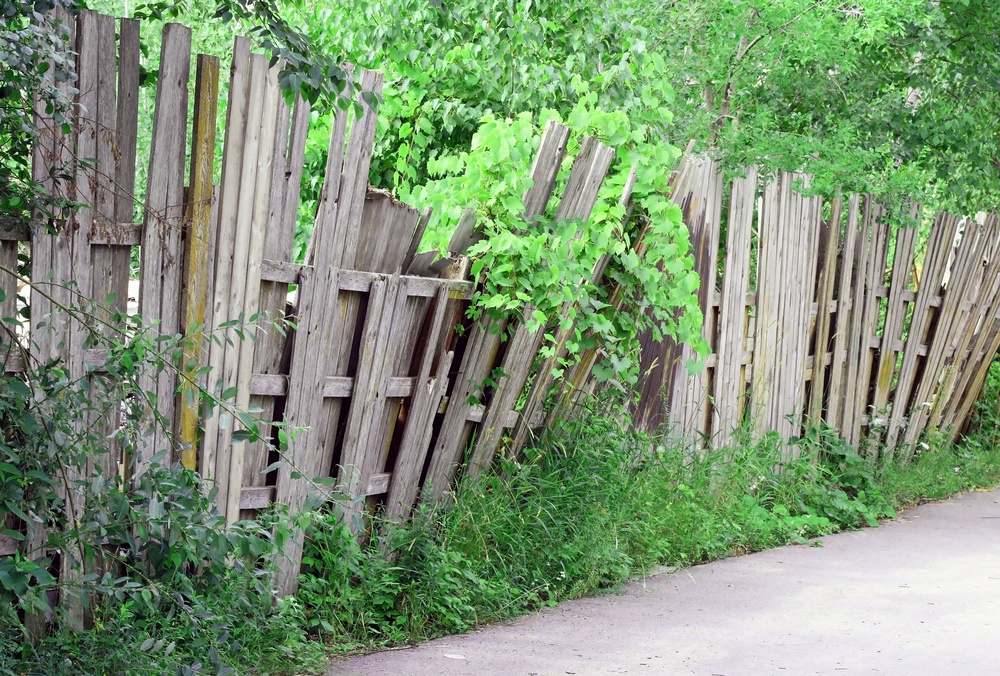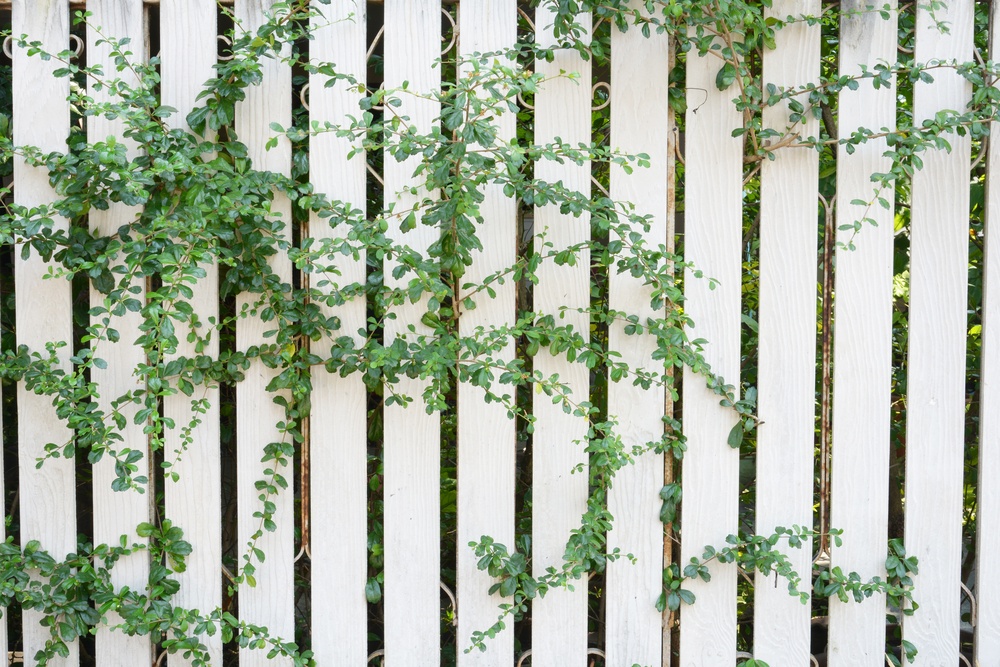A structure covered in vines is one of the most classic and beautiful features you can add to your backyard. Vines climbing a fence not only enhance aesthetic value but make your yard more private. Unfortunately, vines can be as destructive as they are beautiful. They’re resourceful plants that crawl up structures in order to soak up as much sun as they can, and sometimes they hold on tight and bring the structure down. You need to make sure your fence is suitable for vines and also that you’ve chosen a vine that won’t cause damage. So, if your dreams have been full of sprawling ivy, not so fast! Here are some do’s and don’ts to consider before growing vines on your backyard fence.
Vines that Aren’t Fence-Friendly
The types of vines that are most likely to be unfriendly to your fence and your outdoor living space are fast-growing, woody vines and invasive species of vines. Though many of these are beautiful, such as hydrangea or English ivy, they can destroy your fence and shouldn’t even come near it.
Woody Vines
Some woody vines are favorites of gardeners for good reason. Many of them, like wisteria or trumpet vine, bloom with bright, fragrant flowers that attract hummingbirds or butterflies. However, when these vines begin to spread over your wooden fence’s surface, they hold excess moisture against the wood. This opens the door for rot as well as fungus, bugs, and other hazards that can wreak havoc on your fence. The “wood” part of the woody vine’s anatomy can also cause a problem: the vine’s strong wooden roots can get between the slats of a wooden fence or into existing cracks and cause breakage, especially on moisture-softened wood. Rapid-growing woody vines in particular can therefore spell disaster for your fence.
Invasive Species
Many a hapless homeowner has introduced a beautiful vine to their fence, and a short time later, they ended up fighting an ongoing war with a vine that turned out to be a member of an invasive species. Invasive species of vines are often related to native species, like American bittersweet’s relative oriental bittersweet. These unwelcome cousins of naturally-occurring vines have been known to overtake entire geographic regions, choking out ecosystems and individual gardens alike. Invasive species like chocolate vine, English ivy, wintercreeper, and Japanese honeysuckle pose a hazard not only to the environment but to the appearance of your outdoor space.
All of the problems that come with growing woody vines on your fence (the moisture and accompanying structural damage) are compounded by invasive species’ tendencies to grow rapidly on every inch of available space. This includes your fence, lawn, other plants and trees, and even your house if left completely unchecked. Once they take hold of your yard, it’s likely that the only way to get rid of an invasive species is with a series of controlled burns and applications of vine-killing chemicals, both of which are likely to damage to the beloved plants and trees you actually want to keep around.
Fence-Friendly Vines
The type of fence you own determines the type of vine you can safely grow on it. Even the gentlest vines hold moisture against the parts of your wooden fence they touch. However, aluminum and vinyl fences respond well to most types of vines since they are more durable and less vulnerable to environmental damage than wooden fences.
 For Wooden Fences
For Wooden Fences
If you have a wooden fence, most species of vines are likely to be treacherous to your fence’s longevity. The rotting, cracking, twisting, and other structural damage that vines can cause to your wooden fence mean that most species should be kept away.
The safest vines for wooden fences are annual, herbaceous (non-woody) vines. These vines’ stems can wrap around your wooden fence but won’t cause the types of structural damage that woody vines will. You can guide these vines to grow around fence posts or along your fence’s upper support beams, which will provide them with plenty of light while keeping them away from your fence’s more vulnerable slats.
Though they should be removed at the end of the growing season, annual vines like morning glory, moonflower, sweet pea, and climbing nasturtium all work well with wooden fences. These plants are airier than most woody vines, which minimizes any moisture trapped between the plant and the fence. These vines grow readily from seed and can reach lengths of 10 to 15 feet at the peak of the season. They do not provide much privacy, but they do produce flowers that are vibrant in color and sweet in fragrance, brightening up your summer garden and attracting butterflies and birds. Gardeners who like to vary their planting from year to year will enjoy the opportunity to plant new herbaceous vines each growing season.
For Vinyl Fences
Vinyl fences, which are made of hardy, weather-resistant material, can withstand almost anything, so the structural concerns that wooden fence owners have about growing vines on their fences mostly do not apply to vinyl fences.
Because of their durability, vinyl fences are ideal for homeowners who want their climbing vines to enhance the privacy of their spaces. Coral honeysuckle or clematis are perennial vines that climb vinyl fences readily. These plants provide a lot of coverage in a short period of time, and they can usually span the height of your fence within a single growing season.
Though even the strongman-type woody vines will have little structural effect on your vinyl fence, the plant can still trap moisture against your fence, and with moisture comes a whole host of organisms from algae to bugs. Thankfully, algae growth on your vinyl fence is no big deal. Vinyl is a non-porous surface that does not permit staining, making it easy to clean your vinyl fence.
Bugs, on the other hand, could pose a problem. The moisture, delicious plant matter, and tough structure of a bushy vine may seem like a courteous invitation for bugs looking to homestead, placing the other members of your garden in danger. Make sure to check on what bugs, if any, are fans of your chosen vine and take the proper steps against bug infestation to keep the rest of your outdoor space safe.
For Aluminum Fences
Aluminum fences are perhaps the most readily-beautified of all fences. Their durability and open-lattice framework provide an excellent foundation for a “living fence.” Wisteria, climbing hydrangea, rambling roses, and other heavy, strong woody vines that might overwhelm other fences are no match for aluminum, which withstands moisture and resists rust. Even grapevines grow enthusiastically on aluminum fences. These plants can provide full coverage within a few growing seasons, adding intense color and aroma to your space. The thorny stalks of some vines like bougainvillea might even further discourage intruders!
Quick Tips for Growing Vines
- Visit a plant nursery. Taking cuttings of random, pretty vines from wooded areas may leave you quickly rueing your decision and even your very existence if the vines turn out to be invasive. Plant nurseries do not frequently cultivate invasive species since they’re often banned from sale by state governments. However, even vines not considered invasive can overwhelm you and your garden. Nursery staff can provide you with a wealth of information about how you can ensure your chosen vine stays under control.
- Your vines have needs, too! Carefully research your vine’s sunlight, space, and soil requirements. While some vines are relatively low-maintenance, it’s often said that some vines sleep, then creep, then leap – an apt descriptor of how it may take several growing seasons of work to help your vine reach its fullest potential.
- Consider your alternatives. If you have a wooden fence but are dead-set on filling your garden with climbing hydrangea or wisteria, look into other methods of introducing these plants into your space without destroying your fence. Arbors and trellises often provide a good structure for flowering vines to cling to and allow you to keep your vine’s growth in check. Strategically placing these structures can also help you enhance privacy. Many people place a series of posts a few feet inside their fence line and a string wire or other supports between each post, then guide their vines along these wires. Doing so can give you the full, rich look of creeping, climbing vines without putting your fence in danger.

The post Growing Fence-Friendly Vines: Do’s and Don’ts appeared first on The Fence Authority Blog.